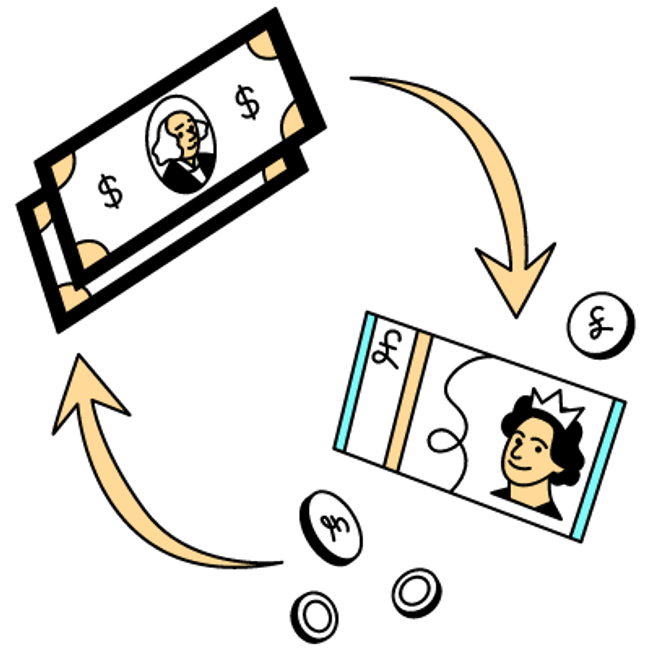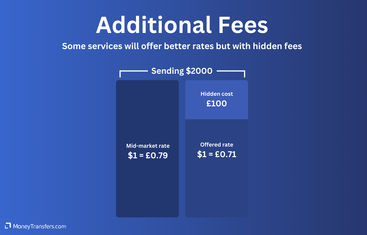Cheapest Ways to Send Money Abroad
When making an international transfer, speed and customer service are important. For many of us, though, nothing beats low fees & great rates.
So who is actually the cheapest right now? The quick answer for many people is Wise.
For a more accurate view, you can compare all our companies & rates with our .
Avoid hidden fees & beat the banks with us today. Read on to learn how to save more on overseas transfers.
Search Now & Save On Your Transfer

Wise is the cheapest online only provider.
Over the last 6 months they were the cheapest option 41% of the time.
In short, the cheapest way to send money is through a money transfer company. The cheapest money transfer company is Wise. Transfers start from a total cost of 0.33%. For a more personal service, you can try Regency FX, which for large transfers can be very competitive on rates.
There are three main ways to send money abroad:
Money transfer companies
Banks
PayPal
Of the three, money transfer companies will offer you the best deal 99% of the time.
Let's use a $1,000 transfer to Europe to explain how it works.
Practical example: Sending $1,000 to Europe
Method | Detail | Mid-Market Rate | Exchange Rate ($1 = €XX) | Fees | Received amount |
|---|---|---|---|---|---|
Money transfer company | A company online, or through an account manager, offering competitive rates on international transfers. | 0.9302 | 0.9378 | $6.42 | €931.73 ✅ |
Bank account | Every day banks, like Chase, offer weaker exchange rates and slower transfers. | 0.9302 | 0.9058 | $5.00 | €900.80 ❌ |
PayPal | Apps like PayPal generally offer the worst exchange rates and add a fee percentage on top. | 0.9302 | 0.8996 | $4.99 + 4.5% | €858.64 ❌ |
Which Money Transfer Company Is Cheapest?
If you want an instant answer, then without knowing the specifics, we'd probably say Wise. They come up cheapest 42% of the time according to our analysis.
However, the truth is, you should always compare before you send, or you might be missing a better deal.
To compare providers for your specific country, currency, amount & payment method, enter your details into our search form.
Money transfer companies generally fit into two categories - online-only providers and managed services.
This table gives an idea of how these two options generally compare:
Type of money transfer company | Quote | Cheapest for | Transfer method | Cost-effective option | Check rates |
|---|---|---|---|---|---|
Online only | Instant | Smaller transfers | Self-service in the login area | Wise | |
Managed service | Custom | Larger transfers | Email or phone, with an account manager | Regency FX |
Here's why we have chosen Wise (online only) and Currencies Direct (managed service) as the cheapest money transfer options based on our data.
The following data highlights the percentage of time that each of the following providers was the cheapest online-only option from the USA for transfers under $1000. This data covers the last 6 months.
Company | Percent of time cheapest (last 6 months) |
|---|---|
Wise | 41.11% |
Global66 | 29.74% |
Instarem | 19.99% |
Remitly | 6.47% |
Xe | 1.48% |
Worldremit | 0.59% |
WesternUnion | 0.32% |
Paypal | 0.09% |
CurrencyFair | 0.09% |
Capital One | 0.09% |
TropiPay | 0.03% |
MoneyGram | 0.00% |
The following data highlights the percentage of time that each of the following providers was the cheapest managed service option from the USA for transfers over $10,000. This data covers the last 6 months.
Company | Percent of time cheapest (last 6 months) |
|---|---|
Currencies Direct | 51.56% |
RegencyFX | 32.29% |
OFX | 10.94% |
TorFX | 5.21% |
Read on to find out how a specialist money transfer company can offer you the cheapest rates & low fees.
Don't forget to compare before you send
Rates, fees & special offers are changing all the time.
The cheapest transfer today might not be the best deal tomorrow.
That’s why we always recommend that you should compare before you send.
What impacts the cost of a money transfer
The amount you're sending, and the rates and fees charged, all impact the cheapest way of sending money.
The more you send, the greater the need for a competitive exchange rate. You’re more likely to get this through using a money transfer company than a bank.
Rates and fees for international money transfers
Here’s how each point impacts the overall cost of sending money.

Mid-market rate
The midpoint between the buy and the sell price of two currencies, without any added fees or margins. Also known as the "real" exchange rates.

Exchange rate
The rate banks, PayPal, or money transfer companies offer you. Typically add a markup to increase profit margin (more on that below).

Fees
Fees are typically included in your quote. So from a $5 fee for sending $5,000 to Spain, The $5 will be deducted first, and you’ll then get $4,995 converted to euro.
Each international money transfer company has its own exchange rate.
Sometimes this matches the mid-market rate, but many companies give you slightly worse rates.
On the other hand, some companies might offer better rates (even better than the mid-market rate at the time of transfer) but charge much higher fees.
This is called the 'markup', or how much-hidden costs are bundled into the exchange rate.

Simply put, this is how much currency you’ll get for your USD. The percentage above the mid-market rate is called the exchange rate markup.
Banks tend to offer much less competitive exchange rates vs. the mid-market rate - we see this as if you’re paying a convenience charge for already having an account and using it, as opposed to shopping around.
This convenience charge pays for intermediaries used by banks to transfer your money.
This is why ‘free’ or ‘low-fee’ transfers aren’t always better, as if you’re paying a higher exchange rate, you still might end up receiving a lot less at the other end of the transfer.
We chose Wise as one of our cheapest options as they offer rates at the mid-market rate and add a small fee (around 0.35%) - which works out cheaper overall for someone sending money.
The location, payment method, and how the money is received
How and when you want to send will also impact the overall cost.
Where you’re sending to might impact the overall cost if it’s considered more ‘difficult’, due to timezone differences and how they impact banking hours or payment networks.
For instance, London is 5 hours ahead of New York. So, if you process a payment at 4 pm on a Friday in New York, it is already 9 pm in London, effectively the weekend for banks.
The method of payment for a transfer can also affect the cost.
Paying in cash in a shop is significantly more expensive than sending via a bank transfer. Again, this cost difference might not be in the form of fees, but in the exchange rate you receive.
How the person receives the money can impact the overall cost (receiving fees) - banks like Chase require a 3% fee for any incoming transfer into the US for example.
So for a $1000 transfer example above, the recipient would receive just €878.63 after receiving fees.
Receiving fees won’t show in calculations given by money transfer companies.
This is because each bank has a different fee structure.
It should be noted these fees aren’t applicable everywhere, but it’s best to check with the person you’re sending money as to who will cover these fees and whether these should be included in your calculation.
The speed and time of a transfer can potentially impact cost in that some providers will charge extra for sending over a weekend, and some providers will offer express services for a higher fee.
Generally, if you want to send quickly, it’s worth paying, but if you just want the cheapest option then you can avoid these express fees and ensure you always send in traditional business hours.
How can money transfer companies offer cheaper options for bank transfers?
When you’re transferring money overseas directly from a bank account, you pay a premium to use intermediaries and as such, bank transfers directly through a bank are more expensive.
.png)
Sending using a bank account isn’t the same as a bank transfer through a money transfer company - where in effect you use a linked bank account to send your money to the company in a local account, and then they will use their network to move the money, and send it back to a recipient from a local account.
This benefit in cost comes as the overheads are lower for a money transfer company, they can use their technology (and fewer intermediaries) to fuel the transfer and charge a fee or markup the exchange rate at a much lower rate than a bank would - and still make money.
Bank transfers through money transfer companies
You will fund a money transfer account through a bank transfer, but as the company carries out the transfer within its own network, you don’t pay the intermediary fees.
Cheapest ways to send money abroad
Here are the cheapest options for transferring money to each of these countries. We have included PayPal and banks to give comparable insight into this data.
Numbers are averages from our data over the last six months and are updated weekly.
These are based on bank transfers to the country.
As we’ve mentioned, the cheapest option for your specific transfer will be different depending on your needs.
We would always recommend to ensure the best deal.
Americas
When talking about The Americas we include North America, South America, Central America, and the Caribbean.
Money Transfer Company | Bank | PayPal | |
|---|---|---|---|
Amount Sent | $1000 | $1000 | $1000 |
Exchange Rate | 18.2597 MXN | 16.543202 MXN | 16.327008 MXN |
Fees | $0 | $5 | $4.99 + 4.5% |
Amount Received | 17,803 MXN | 16,613.98 MXN | 15,668.93 MXN |
1,200 MXN less | 1,500 MXN less |
These numbers are based on transfers from the USA to Mexico using our comparison engine - different countries may have slightly different rates and fees. We always recommend you .
Europe
Sending money to Europe is easy from the US, particularly in the more common routes into the Euro or the British pound.
Euro
Money Transfer Company | Bank | PayPal | |
|---|---|---|---|
Amount Sent | $1000 | $1000 | $1000 |
Exchange Rate | €0.8559 | €0.910207 | €0.899616 |
Fees | $0 | $5 | $4.99 + 4.5% |
Amount Received | €924.50 | €905.20 | €858.64 |
€23 less | €66 less |
British pound
Money Transfer Company | Bank | PayPal | |
|---|---|---|---|
Amount Sent | $1000 | $1000 | $1000 |
Exchange Rate | £0.7482 | £0.785134 | £0.774624 |
Fees | $0 | $5 | $4.99 |
Amount Received | £794.42 | £780.13 | £738.62 |
£14 less | £60 less |
Asia-Pacific
Remittance flows are a significant source of income for many countries in Asia, owing to many from the continent migrating to more developed countries in search of high wages and a better standard of living.
INR
Money Transfer Company | Bank | PayPal | |
|---|---|---|---|
Amount Sent | $1000 | $1000 | $1000 |
Exchange Rate | 91.7768 INR | 80.8914 INR | 79.962048 INR |
Fees | $0.99 | $5 | $4.99 |
Amount Received | 82,651.13 INR | 80,486.94 INR | 79,563.03 INR |
2,165 INR less | 3,088 INR less |
For regular cheap transfers, we recommend using Wise (or their multi-currency account option).
Wise is listed as our cheapest option 42% of the time.
They offer the cheapest transfers more than anybody else because they match the mid-market rate.
This is offset by Wise having fees associated with transfers which in some cases are higher than competitors. However, these set fees, are outweighed by the savings you will make on the competitive exchange rates offered.
This is why Wise is seen as having a 'transparent fee structure'. Essentially, you are paying the most competitive rate for the transfer possible, but paying a small fee to Wise to carry out the transfer for you.
Just a note: Bank transfers through Wise are the most cost-effective transfer, using a debit card as a payment on average adds 0.20% to the overall cost of a transfer because of a debit card interchange in Europe.
Aspora (previously Vance) is currently the cheapest option for transfers to India from the UK, Ireland, Italy, and the United Arab Emirates.
They charge up to £3/€3 on money transfers from the UK, IE, IT, and 0 AED on transfers from the UAE.
Aspora uses the mid-market rate (just like Wise), meaning there is no markup added to your transfers.
We've run a few tests (more on that in our Aspora review) and found that Aspora is cheaper than Wise when it comes to sending money to India.
How the purpose can impact the cost
Regular or large payments, or business payments (which tend to be both) can mount in cost over time. Bigger payments could mean bigger fees, even with a good exchange rate.
This is why we suggest using currency brokers (managed services) for transfers over $10,000.
At the opposite end, if you make regular small payments of $200, a $3 fee will add up over the course of the year.
Common Reasons For Transfer

Sending money home
Reviewing the cost of regular transfers, like any regular payment sent home, is essential.
Whilst Revolut might be the cheapest provider for sending $1000 to Mexico today, but that might change over time - so don’t limit yourself to that one option.
On top of this, if the regular payment is incurring a fee for a better rate, then be sure to work out the cost over time for these transfers.
It may be that paying a one-off fee is cheaper, but further down the line becomes a less cost-effective way of transferring.
Track the cheapest transfer deals
Get updates on the cheapest deals for your recurring transfer by signing up for alerts.
Buying a property abroad
As you’ll see in the above tables, the greater the amount you transfer the bigger impact exchange rates will have on our overall cost.
If for every $1000 you lose €30 at the other end, a $10000 transfer could cost the recipient upwards of €300.
For payments over $10,000, it would be best to go with a managed service (also known as a currency broker).
Managed services offer competitive exchange rates and will have an account manager dedicated to your account and transfers.
For the most part, a currency broker will also be fee-free, as they make their money in the exchange rate charged.
For large transfers, the cheapest money transfer company we recommend is Currencies Direct.
Currencies Direct is our choice low low-cost, large transfers. They were the cheapest managed service in 52% of searches over the last 6 months.
As a managed service, they will provide you with a point of contact to carry out the transfer.
For larger transfers they also allow you to determine a target exchange rate and buy the currency on your behalf when it's hit. This can potentially slow down the transfer in time, but when working with significant sums of money can make a huge difference in overall cost.
There's also the option for forward contracts, where you can lock in an agreed exchange rate in advance for when you want to send.
Most managed services will give you the exact exchange rate when enquiring - but the average for Currencies Direct over the last 6 months has been between 0.7-1.7%, with no fees added.
In comparison, sending through a bank could cost upwards of 8% when fees and less competitive exchange rates are factored in.
Buying Property Abroad

Buying overseas property is an exciting move. Whether it's an investment or a place to call home, you'll want to manage your FX exposure and costs carefully.

Business payments
The cheapest way for transferring money for business purposes will likely need to account for both regular payments and large payments.
Business money transfers need to have further considerations for forward contracts and the potential to control exchange rates.
Explore transfers for business

Business transfers can differ in needs. Find out more about global transfer, managing multiple currencies and the cheapest ways to make mass payments.

Cheapest payment methods
Money transfer providers are the cheapest way to send money internationally. They keep their overheads low and don’t need to physically send money overseas.
However, you still need to fund your account in the most cost-effective way.
Bank transfers - The cheapest deposit option
When using money transfer services, bank transfers are more often the cheapest way of sending money.
To recap from our earlier point, using your bank account to directly transfer money is not the cheapest way to send money abroad, but a bank transfer payment through money transfer services is often the best option.
This is because ‘traditional bank transfers’ typically involve more intermediaries, each adding fees and margins.
While money transfer companies have streamlined processes specific to the transfer process and operate primarily online, which reduces the need for multiple systems and physical branches, and the associated costs that come with both. A small point that adds up.
A money transfer company will often use local accounts. You give your money to a company in your location, they withdraw the money in the destination country, and the recipient receives that money.

Large transfer
For large transfers, funding a money transfer provider through a bank transfer will likely be the only option.
Debit cards - A good alternative
Sending with a debit card will be convenient, but not likely not the cheapest option.
It is possible to send money using a debit card in instances where you don’t want to provide bank details, or are using a prepaid card.
Whilst this can still be cheap to do through a money transfer company, it also can come with higher fees - it’s still a viable option, however.
Credit cards - Not recommended option
A credit card transfer is not the cheapest option.
Credit card transfers are similar to debit cards, although some companies won’t accept them.
We’d also suggest avoiding using a credit card for an international money transfer unless necessary due to the fees and interest rate paid after the transfer to your credit card provider.
Compare money transfer rates
Cash - Last resort
If necessary, cash is a possible payment method - but it’s likely you will pay a much higher exchange rate as you will need to go to a physical location to make the transfer (essentially the associated cost of running the location will be included in the exchange rate).
A few common places to deposit and send cash are Western Union and MoneyGram.
Generally, we would recommend sending money electronically unless absolutely necessary.
Best receiving options
Being able to send money is half the problem, the receiver will also need to be able to receive money cheaply and conveniently.
Multi-currency accounts and money transfer apps
Receiving money into a provider app or portal - like a multi-currency account or wallet - is a great option.
If you’re sending between Wise and Wise, for example, this makes the process even easier.
Bank account
A bank account is the most convenient way of receiving money in most cases.
If you’re making large purchases, you will likely be sending to the bank account of a legal company as well.
As mentioned, be aware of any receiving fees - generally a minimum fee, or a percentage of the transfer.
Cash pickup
Cash pickup is a common option for countries where banking rates are lower. Whilst convenient, they can come at an increased cost.
Using MoneyGram as an example, a fee for a $500 transfer for cash pickup is $68.99. For comparison, the cost of sending to a bank account is $8.99.
Prepaid cards
Sending money to a prepaid card is a simple way to receive money. It is increasing in popularity due to the high cost of sending for cash pickup.
This method is similar to a bank transfer with, the slight nuance that a card has to be ‘prepaid’, almost like a gift card.
Are you sacrificing anything for cheaper options?

By opting for a money transfer provider over a bank you are not sacrificing anything. You’ll get a better rate and lower fees.
These also come with tiers, so going for the cheapest option with a money transfer provider could mean a slightly slower speed of transfer.
However, this will still be faster than using a bank.
Think of this in a similar way to Netflix subscription options.
At one end you have the budget option which comes with ads and standard-definition viewing.
At the other end, you have premium - where you can use multiple devices, download, have no ads, and view in 4k.
Are there any other ways to minimize cost?
The standard way to minimize cost is to follow the above points and compare rates for the transfer you want to make.
Generally, the points to consider outside of this are:
Avoid using credit cards
We’ve mentioned credit cards already not being the cheapest way to send, but it should be reiterated that unless an absolute emergency, this should be avoided.
Interest rates and fees on using credit cards add a hidden cost if the amount remains unpaid for a longer period of time.
Avoid banks
Send at the right time
Understand where the money is going
Risk management and hedging
Edge cases and workarounds: How do they stack up?
There are a few other ways to work around transferring money affordability, although each is a little more manual and will have limits (such as the amount of money you can transfer).
We’ve outlined some below.
HSBC accounts
For those with an HSBC checking account it is possible to open either a global money account or in some cases an account in say Japan, as you’re an existing customer.
From here, you can transfer money between your accounts at a fairly competitive rate - with the added bonus of using the card in that country as well.
The downside here is the obvious, if you do not have an HSBC account, you wouldn’t be able to do this - but also beyond this, amounts are limited to lower numbers than a standard money transfer company.
Potentially a good option for regular travelers who want to use the account, but unlikely to be much use for things like sending money to family and friends, or buying a property.
Crypto payments
Crypto has been used for international transfers in specific cases where traditional transfers aren’t always possible.
For example - USDT
For example, USDT (a cryptocurrency that matches the US dollar) payments to Ukraine have increased for both donations and personal use since the start of Russia’s invasion into the country. This is because banks were unable to process all payments, but cryptocurrencies work outside of the standard banking network.
With international crypto transfers, there are no currency conversion fees because you are in theory moving one currency between accounts.
You will likely pay a small percentage of the amount to the provider of the transfer.
Whilst crypto payments offer alternative options and are relatively cheap (depending on the choice), it does mean you will have to buy the cryptocurrency which has its own fee, as well as sell it to get the currency at the other end - again with a fee.
When considered alongside sending and paying a small exchange rate and fee through a money transfer company - the amount you’ll spend will generally not be worthwhile.
Money transfer company | Cryptocurrency payment | |
|---|---|---|
Amount sent | $1000 | $1000 |
Buy USDT | $0 | Up to 3.75% |
Fees to send | $8.63 | $0.00 |
Cost to withdraw USDT to EUR | $0.00 | Up to 3.75% |
Exchange rate to EUR | €0.9335 | Varies by network |
Amount received | €924.50 | €922.00 (maximum) |
If you’re already using cryptocurrency it could be a good idea for smaller amounts, but for things like buying property, there will likely also be huge amounts of tax to pay upon withdrawal, and proof of source of funds will be difficult.
Regulation (or lack of it in certain countries) of cryptocurrency assets makes sending unpredictable, as well as the volatility in the market.
Use regulated option
As such we would recommend using a safer, regulated option for transfers - as this will be both cheaper and easier for you in the long run.
ATM Transfers
ATM transfers are a good option if transferring less than $1,000 and can offer an element of speed and convenience if you’re against signing up for a new provider and are in the vicinity of an ATM.
Over $1,000 becomes quite difficult and time-consuming.
However, whilst three-digit transfers are free they can take a huge amount of time compared with signing up to a money transfer provider.
Premium accounts and multi-currency accounts
If you’re a regular traveler, or regularly sending smaller amounts of money home or to a relative - then the cheapest way may be to get a premium bank account that comes with lower limits or costs for regular transfers than the standard rates mentioned above.
Outside of this, and slightly crossing over, are multi-currency accounts.
Both offer elements of freedom and flexibility when it comes to sending money, as well as holding money in different currencies.
Generally, you would still get a better rate and more freedom using a multi-currency account from a money transfer provider.
For example, Wise has no ongoing fees, Revolut Premium is $9.99 per month and the Citibank International Account is up to $150 a month (depending on the amount of cash held.
A full breakdown is here:
Wise Multi-Currency Account | Revolut Premium | Citibank (now NAB) | |
|---|---|---|---|
Holding currencies supported | 50+ | 37 | 21 |
Monthly fee | $0.00 | $9.99 | Up to $150 |
Average exchange rate markup | 0.2% | 0.73% | 1.5%* |
*It has been noted that some users were incorrectly told by Citibank that they would get the Mastercard exchange rate on international bank transfers but this is not the case. The Mastercard conversion rate is for withdrawing cash on an international ATM only - so would be limited to the withdrawal amount you can make.
PayPal and other P2P apps
P2P payment apps like PayPal can be used to make international money transfers to the recipient’s linked bank account, but they’re not very cheap.
PayPal fees for sending money average at around 5% per international transfer, with a markup of 3% - 4% on the exchange rate.
The cheapest payment app that can be used for P2P transfers is Wise or Revolut.
Email money transfers
Similar to P2P apps, some money transfer providers, like Wise, let you send money overseas via email. They do this using their own P2P payment system.
This allows you to cheaply send money internationally to people without a bank account. If you want to send an email transfer, the recipient will need to have an account (and the app in most cases) with the money transfer provider you’re using.
Recapping
Ultimately, the cheapest way to send money is through a dedicated provider where you will get:
A better exchange rate on your dollars
Lower fees on sending money
Quicker transfers
Ongoing support from an account manager (when opting for a currency broker)
Dedicated customer service support (when using an app or online transfer provider)
As mentioned, you should always search in line with the transfer you want to make to get a live cost and compare the best option at this moment in time.
Get the cheapest transfer options
Sources and further reading
Internal analysis of transfer costs and fees over the past 6 months
Related Content


Contributors



.svg)

.svg)

.svg)








